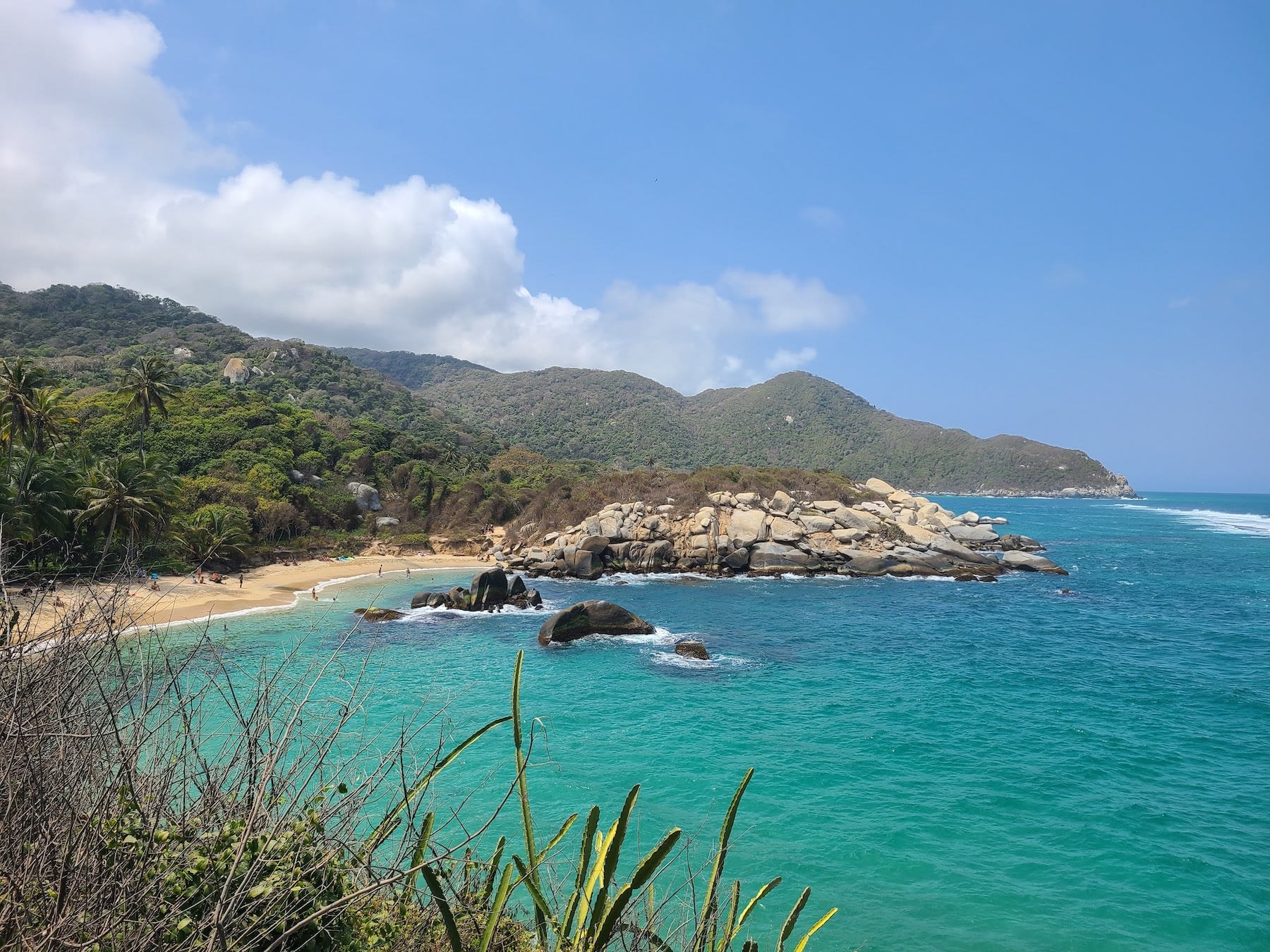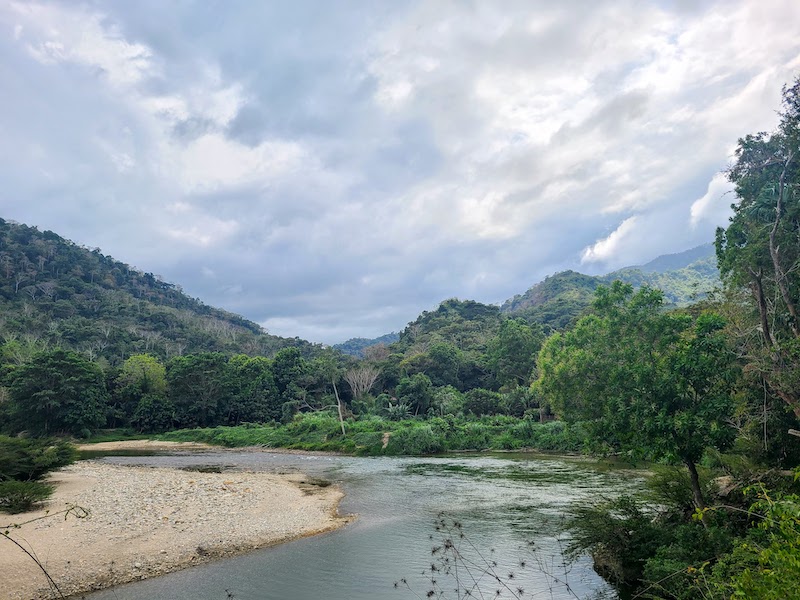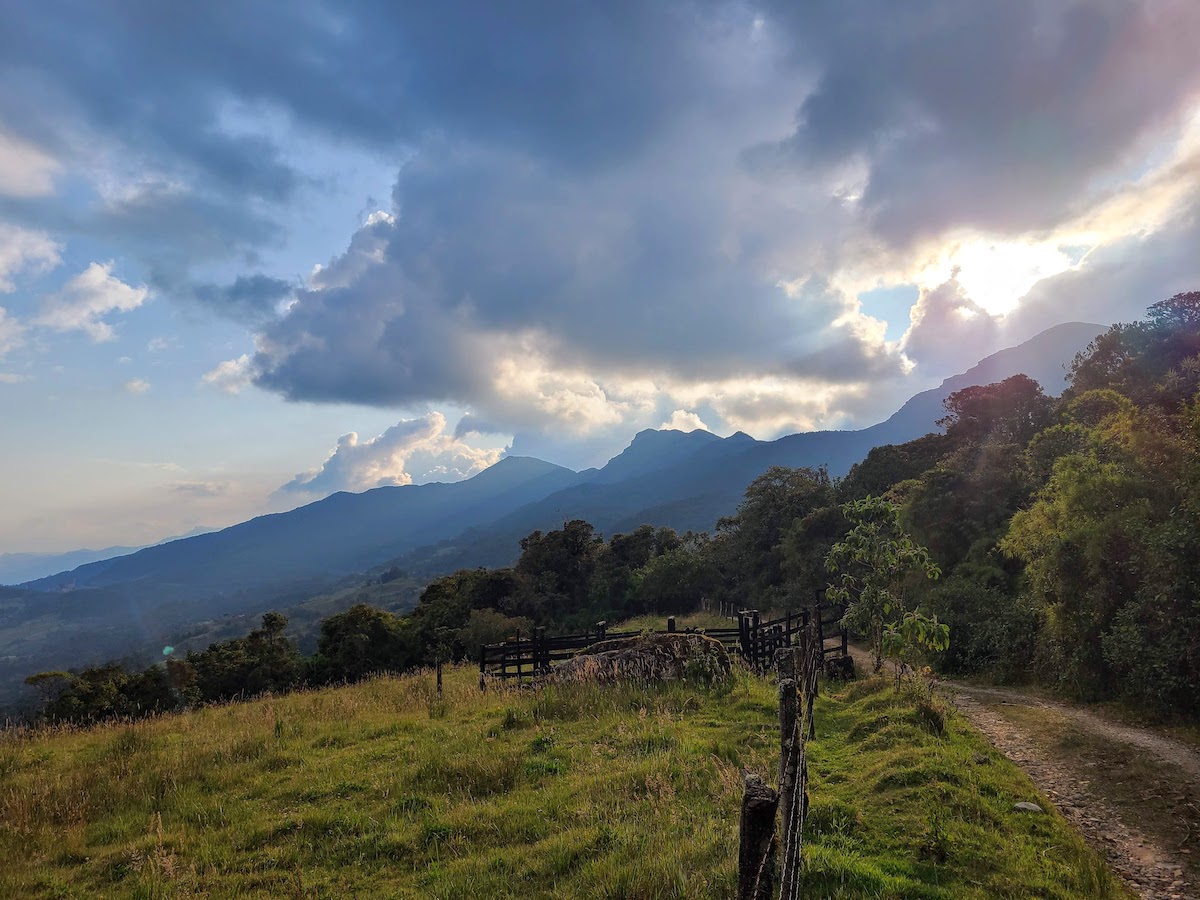A Comprehensive Guide to Tayrona and the Surrounding Area


Tayrona National Park, nestled on the Caribbean coast, is frequently listed as a must-visit destination in Colombia. It’s a great place for birding, and nearby some other top-notch birding destinations (Minca and La Guajira). Here’s a comprehensive guide, including information on getting there, accommodation options, alternative day trips, what to do in Tayrona, and of course, the birds you can see!
Getting There
I flew from Bogota to the Santa Marta airport. I was delayed (again) and landed around 5pm. It’s a small airport and I think all the buses outside go to Santa Marta. A taxi driver told me I wouldn’t be able to get a bus towards Tayrona from the city due to the hour, but I decided to try anyways because I wasn’t about to pay for a taxi on my own. As luck would have it, I got the last bus of the evening around 6-6:30. Catch the bus here, at Carrera 9 & Calle 11.
Where to Stay
There are so many options for accommodations in the area and so many of them look really cool. I stayed at two, The Valley Tayrona and Tayrona Paradise.
The Valley Tayrona
I booked my stay on Hostelworld. They have a new(ish) feature that allows you to chat with people ahead of time. I never did make plans with others (mostly because I wanted to bird alone lol), but maybe next time.

The Valley Tayrona was amazing! It wasn’t the cheapest option, but still a reasonable $14/night for a dorm that is pretty much outside (you have a bug net), which I loved. The hostel is a 15 minute walk into the jungle, so I knew I’d have good birding opportunities right on the property every morning and evening. It wasn’t very noisy other than the night it was windy, but I always travel with ear plugs. The excellent onsite restaurant was an added bonus!

The rest of the surrounding area is much more lush.
There are a couple of different dorm and private room options. I stayed in a 4-bed dorm. They were several hooks, which is always appreciated. The bathrooms were also open to the air, except for the one located in the eatery. There were two shower stalls. Everything was clean.
The Food

The food was so good here. It is more expensive than the rest of the area, but I thought it was worth it, plus the portions were big. Lots of good options, including for vegetarians. The juices were great and there is a happy hour every evening.
The kitchen is not available for guest use and there is nowhere to store your own food.
The Wildlife
I birded every morning and evening here and saw new species every day. A couple highlights were a White-bearded Manakin and Barred Antshrike. At the end of the post, you’ll find a full list of birds. I also saw a snake, Titi monkeys, and a squirrel, and heard howler monkeys off in the distance.

They fed the Titi Monkeys here, which I’m not sure how I feel about that. Generally, feeding wildlife is a big no-no. I’d love to know how a local conservation organization feels about it, as they are an endangered species.



They also had this adorable little kitten. I love cats, but I know they’re a huge detriment to wildlife so it does give me mixed feelings.
The Tick Fiasco
The hostel had a really good guidebook and interesting information about the owners and how they created the place. They offered a birding tour with Jungle Joe, which I of course signed up for.
We set out the next morning, and less than 20 minutes into the hike, I looked down and realized I was absolutely COVERED in ticks. I’m talking hundreds. I have experience doing field work in tick country, but this was a lot even for me. Needless to say, we turned around and went back.
After showering, washing my hair and scrubbing my body, twice, I hoped I’d be safe. I rinsed my clothes too and then tied them up in a plastic bag.
You’re probably not surprised, but I was definitely not safe and pulled several ticks off me the next few days.

At the next hotel, I sent out my clothes to be washed. My pants and three pairs of socks didn’t come back. The loss of the socks really sucked, because it proved to be nearly impossible to find good quality socks in the whole entire country. Yes, I know this is whiny, but socks can make a huge difference. I love Smartwool and Darn Tough socks.
Tayrona Paradise
Tayrona Paradise is a mid-range hotel. I stayed in one of their cute little cabins. I would’ve been perfectly happy to stay at the hostel (despite the ticks), but I was meeting my mom here! And a hostel dorm wasn’t gonna cut it. The hotel was fine, but nothing spectacular. The food was okay for a night or two, but by the third we were pretty sick of it. All of the staff were nice and we got to see Titi monkeys (fully in the wild)!

Visiting Tayrona National Park
Park Info
The entrance fee varies throughout the year (link to official website):
High season:
- Dec 1st to Jan 31st
- June 1st to July 31st
- Semana Santa (varies depending on when easter falls)
- Local holidays – look them up
Fee: $73,500 COP
Low season is anytime outside of these dates and the cost is $62,000 COP. I went in early March and the weather was great. Hot and humid, of course, but sunny and not muddy (rainy season is typically during the northern hemisphere’s fall).
NOTE: Tayrona is closed during the month of February every year
You’re supposed to have the yellow fever vaccination to visit the park. From research and personal experience, it seems that this is never asked for. Pro tip: you can get the vaccination for free at the Bogota airport!
You’ll need to pay the entrance fee in cash, plus anything you want to buy in the park (food, snacks, bathroom). On top of the entrance fee, I’d bring around 75,000 extra per person. This is probably a bit on the high side, but just in case. You don’t want to be stuck without money.
Getting There
To get to Tayrona from Santa Marta, you can catch a bus here at Carrera 9 & Calle 11. One leaves every half hour or so and the last one of the day leaves around 6. Tell the driver “Calabazo” and they’ll drop you off.
If you’re already in the Tayrona area, walk to the main road from your accommodation and wait for a green and white bus heading (probably) west (towards Santa Marta). I say probably because most accommodations are within a couple miles of the El Zaino entrance. Here’s a pin of the Calabazo entrance to figure out if you need to go east or wet.
When you get on the bus, tell the driver Calabazo. They’ll let you know when to get off, or keep and eye on where you are on Google Maps (tip: download offline areas).
What to do in Tayrona: A One Day Itinerary

If you only have one day to visit Tayrona National Park, you still have an opportunity to see some spectacular wildlife.
There are two main entrances: Calabazo and the more popular El Zaino. The lines can be super long at El Zaino so you must get there early (like 7am), otherwise you may not be let into the park due to daily limits. If you choose this entrance, avoid weekends and holidays.
My original plan was to hike in and stay at Playa Brava for one night (the orange trail), but because of the tick fiasco I opted not to spend a night in the park. If you have the time, you should try to stay there. It looks amazing and there is hardly anyone else around.
Hike from Calabazo to El Zaino
If you only have a day, the best hike to do is from Calabazo to Cabo San Juan and exit through El Zaino. Entering through Calabazo gives you a better chance at encountering wildlife due to the fact that it is much less crowded. We only passed a handful of people during the first half of the hike.

After paying the entrance fee, you can either hike mostly uphill along a dirt road for the first several miles or you can hire a person to take you up on their motorcycle. I had debated whether or not we should walk or take a motorcycle because I had read there can be good wildlife spotting on both this road and the road from the El Zaino entrance. I’m SO GLAD we took the bikes because we were exhausted by the end of the day. The cost was $20k COP each.
It’s best to go from Calabazo to El Zaino because it is predominantly downhill. We passed several people who were going the other way, hiking uphill for hours in the afternoon heat. Don’t let that be you, unless you really love to suffer.

That being said, the hike was definitely tough and long regardless. We started hiking around 8am and got our first view of the ocean a little before 11. Granted, we were going slow to look for birds and wildlife.
AllTrails, a website that has maps of hikes worldwide, says it’s 19 miles. I don’t think it’s quite that far, especially if you take the motorcycle on the first purple section on the left and the van on the right purple section (in the map at the top).
During this first half of the hike (before getting to beach and the more popular areas) is when we saw pretty much all the wildlife. We didn’t see much on our hike out.
I got this horrible video of two Lance-tailed Manakins performing a mating dance! It was so exciting. I had seen this in a nature documentary before and the crew had spent days trying to find this bird so I felt very fortunate to have not only heard it just off the trail, but to get to see them dance too.
We also saw Howler monkeys and a Keel-billed toucan! I’ll include a full list of birds at the bottom of the post. We didn’t see Titi monkeys in the park, but we did at our hotels.
We finally made it down to the first beach, Playa Nudista by 11:20. It’s another 10-15 minutes to Cabo San Juan, which is one of the only beaches you can swim at. It’s also the main place to camp (although there are others that are less crowded) and there’s a restaurant


The restaurant prices were higher than average, but the portions were huge (plus you’re hours away from the road so to be expected). My mom and I got some smoothies and split the meal even with all our hiking. You’ll need cash to pay for food and the bathroom. We got in the ocean for a bit and rested up before completing the hike out.
I thought the hike out was going to be easier and flat. It was to an extent, but it was still long and hard. Apparently we’re just very slow because even the elderly and the very young (toddlers) were passing us. It was honestly quite comical.

At the end of the trail, there are mini buses that will take you back to the road. By that point, we would’ve gladly paid $100 to be carried home, but fortunately it was only about $4 USD each. We packed into one with a bunch of other sweaty tourists and then caught another bus along the main road to get back to our hotel. Including the travel and lunch time, the hike took us about 10 hours.

There you have it! One day in Tayrona National Park. It was a long day, but overall it was a good experience. Even though it’s very touristy, I still recommend visiting Tayrona. If you’re able to spend a night or two on the park, you’ll likely see a lot more wildlife.
Where to go (other than Tayrona)
There are plenty of other sites to see in the area other than Tayrona. Here are a few suggestions.
NOTE: please help keep waterways clean by not using bug spray with deet or chemical sunscreens. I use the bug stick from Chagrin Valley, make my own sunscreen (or buy a physical sunscreen with zinc oxide), and use natural deodorants. You’ll be bitten by bugs regardless of what you use. It’s best to just wear pants and long-sleeves to protect yourself from bugs and the sun.
Cascada El Saltillo

Before my mom arrived, I went to Cascada El Saltillo. This is not a well-known waterfall, so I was hoping for some isolation to enjoy the day outside and to see some birds! I found out about it from the activity book at The Valley Tayrona. To get there, I hopped on a bus heading east (towards Palomino).
I checked with some locals on the bus and they didn’t know where I was trying to go and kept directing me to Quebrada Valencia, the well-known waterfall I mention below. Fortunately, I found it on Google Maps and followed the river to the road to see where I needed to get off.

As I walked down the road, people still weren’t sure where I was trying to go, so I was definitely a bit nervous, but kept going anyways. You’ll pass a tubing area with a lot of locals. Again, I asked for directions. This time, somebody was pretty sure it was down the path to the right, which is a sandy road along a fence line.
It eventually gets into the woods and keep following the trail from there. I got lost and ended up at a house. Fortunately, I ran into a woman and a boy. The boy walked me back to the dry riverbed and we went “upstream” from there. So here are my suggestions:
Keep right along the banana trees shortly after a Flora sign (painted sign) in a fruit tree. If you get to the dry creek bed and see a Guachaca Reserve sign, you’ve gone too far. You can either turn around or hike up the dry creek bed until you see the trail cut-across, like I did (I saw a tinamou!). About a 5-10 minute walk.


Later on in the hike I got lost again. So, a few minutes after crossing the stream (wet, not a dry bed), keep to the right at the cluster of three trees, one of which is a stump. You should be able to find your way easily from here.
If I hadn’t gotten lost those couple of times, the hike would’ve been easy-moderate, but I made a few mistakes that had me going up and down a lot so it was quite hot and tiring. I almost turned around the second time I got lost, but was so glad I pushed through. The waterfall was beautiful and there’s nothing like swimming out in the jungle by yourself. In total, it took me around 4 hours.

Birds:
Little Tinamou, Ruddy Ground Dove, White-tipped Dove, Neotropic Cormorant, Black Vulture, Whooping Motmot, Green Kingfisher, Rufous-tailed Jacamar, Great Kiskadee, Tropical Kingbird, Pale-breasted Thrush, Prothonotary Warbler, Crimson-backed Tanager, Blue-gray Tanager, Olive-gray Saltator, Louisiana/Northern Waterthrush, hermit sp.
Quebrada Valencia

This is a very-well known waterfall in the area and will likely be crowded. During the summer/dry season (Dec-Mar), it will likely have less water and be a bit less impressive. I chose to do it anyways because it was my mom’s first full day in the country and figured it would be a nice, relatively easy hike to get her acclimated.
The entrance fee was $5k COP and the hike is flat to get to the waterfall. It takes about 30 minutes each way (longer if you’re birding), crossing the shallow river several times. You can get to it easily on the bus.
Birds:
Squirrel Cuckoo, Gartered Trogon, Green Kingfisher, Rufous-tailed Jacamar, Streak-headed Woodcreeper, Black Phoebe, Bicolored Wren, Black-and-white Warbler, Prothonotary Warbler, Crimson-backed Tanager, Tropical Parula
Pozo del Amor

Pozo del Amor is a refreshing little swimming hole. It was about a 15 minute walk from the hotel I stayed at, Tayrona Paradise. It’s free and easily accessible. We went in the late afternoon/evening after my mom arrived, and had it to ourselves.
Other Sites to Visit
Some other places I researched, but didn’t visit are:
Conclusion
Despite its touristy reputation, Tayrona National Park offers a captivating experience. If you have the time, spend a night or two in the park to increase your chances of wildlife sightings. Explore the diverse attractions in the surrounding area for a well-rounded Colombian adventure. Enjoy your travels!
Bird Count
Saw 57 species in 4.5 days. Most exciting for me were the Rufous-tailed Jacamar and the Lance-tailed Manakins.
Most frequently seen:
Blue-gray Tanager
Bicolored Wren
Tropical Kingbird
Black Vulture
Olive-gray Saltator
Full List:
Baltimore Oriole
Bananaquit
Barred Antshrike
Bicolored Wren
Black Phoebe
Black Vulture
Black-and-white Seedeater
Black-and-white Warbler
Black-chested Jay
Blue-black Grassquit
Blue-gray Tanager
Blue-headed Parrot
Brown Pelican
Crested Caracara
Crimson-backed Tanager
Crimson-crested Woodpecker
Dull-colored Grassquit
Gartered Trogon
Gray Seedeater
Great Kiskadee
Green Kingfisher
Keel-billed Toucan
Lance-tailed Manakin
Little Tinamou
Louisiana/Northern Waterthrush
Magnificent Frigatebird
Masked Tityra
Neotropic Cormorant
Olive-gray Saltator
Orange-chinned Parakeet
Orange-crowned Oriole
Osprey
Pale-breasted Thrush
Palm Tanager
Plain-brown Woodcreeper
Prothonotary Warbler
Purple Honeycreeper
Red-crowned Woodpecker
Ruddy Ground Dove
Rufous-tailed Hummingbird
Rufous-tailed Jacamar
Smooth-billed Ani
Smooth-billed/Groove-billed Ani
Social Flycatcher
Squirrel Cuckoo
Straight-billed Woodcreeper
Streak-headed Woodcreeper
Streaked Flycatcher
Thick-billed Euphonia
Tropical Kingbird
Tropical Parula
Western Cattle Egret
White-bearded Manakin
White-necked Jacobin
White-tipped Dove
Whooping Motmot
Yellow-headed Caracara


